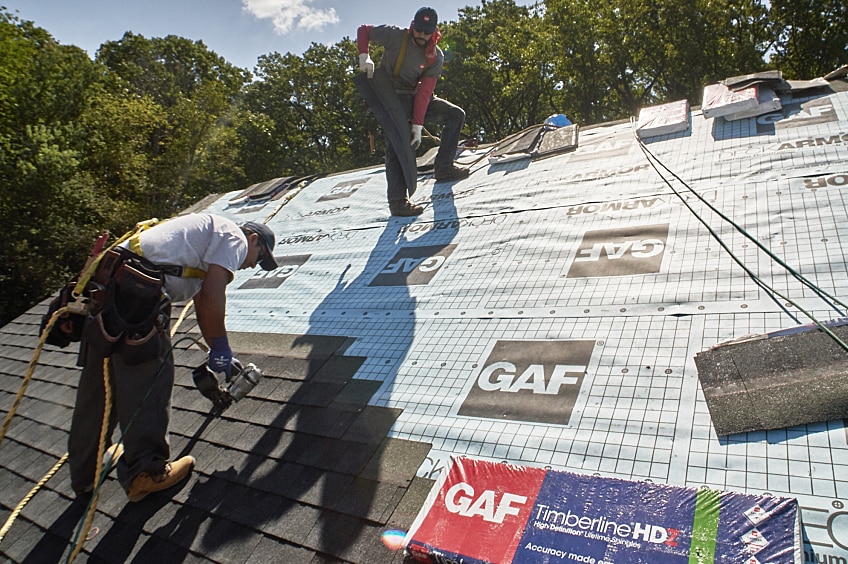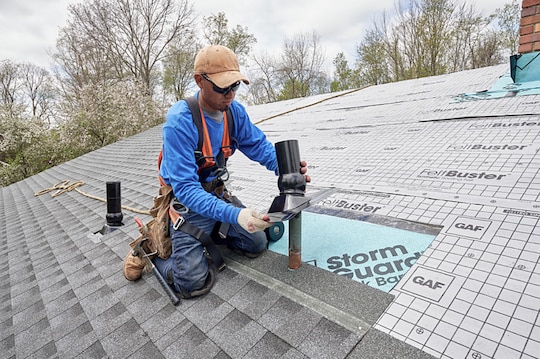
Les saisons changent et les installations des toits changent avec elles.
Selon votre région, le climat local peut exposer les systèmes de toitures à des températures élevées ou basses extrêmes. In most cases, Timberline® HDZ shingles can be installed year round—however, taking a few smart precautions helps to ensure that your customers' roofs stand the test of time.
Consider Hand-Sealing Shingles
Hand-sealing is a method that enhances the sealing of asphalt shingles that needs to adhere to ASTM D4586 Type I or Type II. It's most common to hand-seal when faced with very steep slopes, high-wind areas, and installations during cold weather. If there is insufficient heat, the sealant on the shingles may not adhere and activate, requiring hand-sealing.
Installers should hand-seal shingles:
- In cold weather during fall and winter
- On slopes steeper than 21:12
- On mansard roofs
- While performing repairs
- After adding rooftop accessories such as power vents or skylights (that require removal/re-sealing of shingles)
- When installing shingles up the rake of the roof for added wind protection
- In wind-blown, dusty, and sandy areas
Hand-sealing involves using a caulking gun or small trowel to place a quarter-sized amount of roofing cement under the shingle to be sealed. The shingle is then pressed into the roofing cement and fully sealed. However, using too much cement can force it to run down the face of the shingle or cause blistering.
To determine the right number and location of the dabs of roofing cement, check the shingle application instructions. All GAF shingle and ridge cap shingle instructions include hand-sealing procedures; just follow the directions for the particular shingle you're installing.
Beware of Temperature Extremes
Roofing best practices are to avoid installation in extreme temperatures. However, there may be occasions in which it cannot be avoided. In those cases, installers need to take additional precautions.
During installations in cold weather, installers should:
- Store shingles in an area that is heated above 70°F the day before installation. This will make the shingles more pliable and easier to install.
- Adjust the sealing time depending on the slope of the roof. The roof's orientation and level of exposure to sun and heat exposure can also affect the timing. Shingles may need to be hand-sealed if the temperature is too low to activate the adhesive promptly.
During installations in hot weather, installers should:
- Store shingles in the shade or out of the sun to prevent them from sticking together in the bundle.
- Wear shoes with soft soles to prevent scuffing and other shingle damage.
Install StormGuard and WeatherWatch Leak Barriers
Leak barriers such as GAF StormGuard® and WeatherWatch® help prevent water from entering through the roof deck, protecting homeowners from water damage caused by ice dams.
Before installing either leak barrier, it is important to ensure that the roof deck is dry and air temperatures are between 45°F and 120°F. In the event that installation is absolutely necessary in colder temperatures, we recommend you follow these guidelines:
- Ensure that the substrate is clean and dry, and that there is no ice, frost, dew, moisture, dust, or dirt present.
- Store membrane rolls and adhesives overnight at a minimum temperature of 55°F prior to application.
- Keep materials as warm as possible by gradually removing them from the heated storage as they're installed. The membranes must be at least 45°F at the time of application when the air temperature is below 40°F.
- Pre-cut barrier rolls into lengths of 10 to 20 feet.
- Immediately back nail every 18 in. (46 cm) in the top selvage edge of the sheet. This prevents slippage before the sheet adheres to the deck.
- Press the membrane firmly onto the substrate and hand-roll the overlapping area to ensure adhesion.
- Discontinue installation if the membrane is not adhering to the deck or the overlaps are not adhering.
Asphalt Shingle Installation for All Seasons
GAF Timberline® HDZ shingles can be installed year round and in all climate zones. In extreme heat and cold, taking precautions such as preheating shingles in a warm room or storing them in shaded areas helps the adhesive in the shingles adhere to the layers below along with the roof deck.
If you have further concerns or questions regarding installing Timberline® HDZ, StormGuard®, or WeatherWatch® during temperature extremes, contact your local territory manager for more information.



